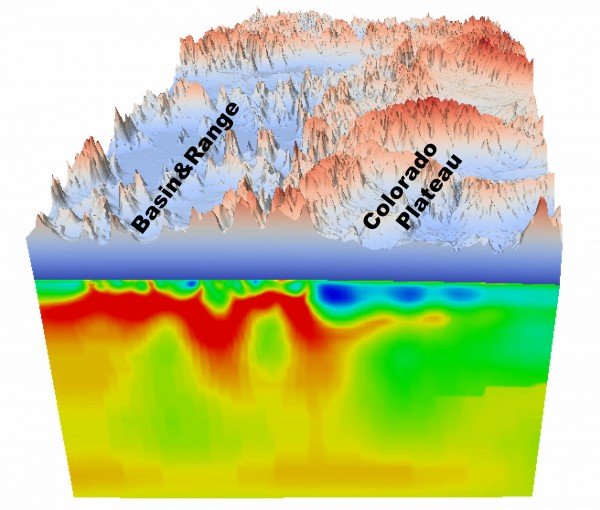New Technique for Finding Weakness in Earth’s Crust

Credit: Jiashun Hu, University of Illinois Geodynamic modelling relies on knowing the ‘viscosity’ or resistance to changing shape of the Earth’s outer layers.
Published in the journal Science today, the research describes a new model of the Earth’s movement in the upper crust through to upper mantle (400km below the surface), allowing predictions at a much smaller scale than previously possible.
The research is a collaboration between researchers at the University of Illinois in the US and University of Adelaide in Australia.
Geodynamic modelling relies on knowing the ‘viscosity’ or resistance to changing shape of the Earth’s outer layers.
“Producing realistic models of these movements has been difficult because the small scale variations in viscosity are often poorly known,” says co-author Dr Derrick Hasterok, from the University of Adelaide’s School of Physical Sciences.
“In essence, we’ve developed a method to estimate small scale (between one and 10 kilometer) variations of viscosity within the upper 400 km of the Earth’s crust using surface-based electromagnetic imaging techniques.”
The resulting model allows the dramatic improvement of flow models which can be used to make predictions about the forces driving tectonic plate deformation and sources of potential seismic and volcanic activity.
“This method will aid our understanding of the processes happening that cause earthquakes and volcanic activity,” says Dr Hasterok. “We’ll be able to see why earthquakes and volcanoes have occurred in the past and look for places where this might potentially happen in the future.”
The method they have developed uses an electromagnetic imaging technique called magnetotellurics to estimate the electrical conductivity beneath the Earth's surface.
“The same factors which affect electrical conductivity ─ temperature, water content, and the presence of molten material (magma) ─ also affect the viscosity or strength. The hotter, wetter or more molten, the weaker the structure,” says lead author Dr Lijun Liu, from the University of Illinois.
“We’ve been able to look at processes operating beneath the Earth’s surface at a much smaller scale than previous geodynamic modelling.”
The researchers used data from a magnetotelluric survery of western United States to show their model works. Currently there is a continent-wide project mapping the Australian upper mantle using the same electromagnetic technique, and the researchers believe applying this data to their new model will bring improved understanding of volcanic and earthquake activity along the southeastern and eastern coast of Australia.
Media Contacts:
Dr Derrick Hasterok
School of Physical Sciences
University of Adelaide
derrick.hasterok@adelaide.edu.au
Dr Lijun Liu
Assistant Professor in Geophysics
University of Illinois at Urbana-Champaign
Phone: +1 217 300 0378
ljliu@illinois.edu
Media Contact
All latest news from the category: Earth Sciences
Earth Sciences (also referred to as Geosciences), which deals with basic issues surrounding our planet, plays a vital role in the area of energy and raw materials supply.
Earth Sciences comprises subjects such as geology, geography, geological informatics, paleontology, mineralogy, petrography, crystallography, geophysics, geodesy, glaciology, cartography, photogrammetry, meteorology and seismology, early-warning systems, earthquake research and polar research.
Newest articles

Combining robotics and ChatGPT
TUM professor uses ChatGPT for choreographies with flying robots. Prof. Angela Schoellig has proved that large language models can be used safely in robotics. ChatGPT develops choreographies for up to…

How the Immune System Learns from Harmless Particles
Our lungs are bombarded by all manner of different particles every single day. Whilst some are perfectly safe for us, others—known as pathogens—have the potential to make us ill. The…

Biomarkers identified for successful treatment of bone marrow tumours
CAR T cell therapy has proven effective in treating various haematological cancers. However, not all patients respond equally well to treatment. In a recent clinical study, researchers from the University…





















